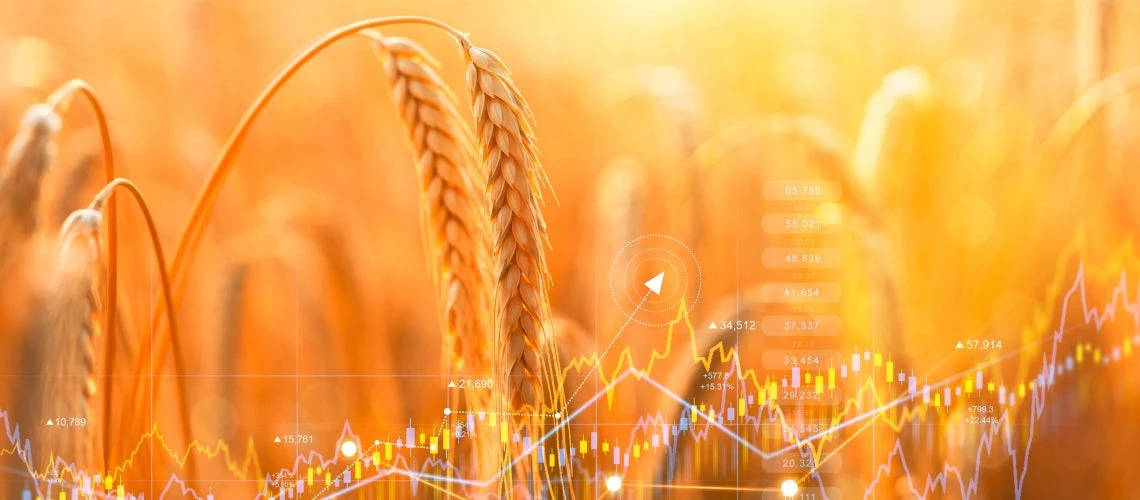 A field of wheat bathed in sunshine with a chart of prices indices overlaid.
A field of wheat bathed in sunshine with a chart of prices indices overlaid.
The war in Ukraine could soon deliver a tragic blow to many of the world’s poorest countries: many of the countries at greatest risk of a debt crisis are now grappling with the threat of a food crisis as well.
Food-import bills are surging fastest for poor countries that are already in debt distress or at high risk of it , the World Bank’s latest data show. Over the next year, the tab for imports of wheat, rice, and maize in these countries is expected to rise by the equivalent of more than 1 percent of GDP. That is more than twice the size of the 2021-2022 increase—and, given the relatively small size of these economies, it’s also twice as large as the expected increase for middle-income economies.
The danger of an overlapping food and debt crisis is greatest for seven countries in particular—those at high risk of debt distress or already in it: Afghanistan, Eritrea, Mauritania, Somalia, Sudan, Tajikistan, and Yemen. But several middle-income countries are at risk as well—including some that are already in the midst of a simultaneous debt and food crisis.
A food crisis is devastating by itself: the 2008 food crisis, for example, spurred a surge in malnutrition, particularly among children. In poor countries, it prompted families to sell household valuables to buy food. It prompted the poorest families to pull their children out of school, precipitating drop-out rates of as much as 50 percent among children from these households. But when a food crisis coincides with a debt crisis, the effects are magnified: the high debt paralyzes local governments, and international assistance becomes the only way out.
The poorest economies—particularly in Africa—happen to be exceptionally dependent on food imports from Russia and Ukraine. As many as 25 African economies, including several of the poorest, import at least one-third of their wheat from those two countries; for 15 of them the proportion is greater than 50 percent. The near-term scope for finding alternative sources within Africa is scant: the regional supply is relatively small—and transport infrastructure and storage capacity is limited in any case.
Debt, moreover, has been a rising problem for these economies—since well before the COVID-19 pandemic. By the end of 2020, the public and publicly guaranteed debt owed by these economies to foreign creditors stood at a record $123.8 billion, an increase of nearly 75 percent from 2010. The debt-service payments of these economies now constitute nearly 10 percent of their export earnings, up from less than 4 percent a decade ago.
These countries were already ill-equipped for the COVID-19 shock, which sent many of them into debt distress. Given the billions in debt-service payments they will need to make this year on their public and publicly guaranteed external debt, their ability to tackle an approaching food crisis will be close to non-existent. They will need help from abroad.
A first step should be to ramp up emergency aid to countries at risk. Over the next 15 months, the World Bank Group will make up to $30 billion available to improve food security in developing economies. Leaders of G7 nations, moreover, have pledged $4.5 billion toward the same goal. International funds should go to people in immediate danger—by helping governments make targeted, cost-effective cash transfers to the most vulnerable households. Such funds should also help at-risk countries make the necessary investments to improve farmers’ access to fertilizers and transform domestic food systems so they can become more productive, efficient, and resilient.
Beyond offering emergency aid, all countries share an obligation not to make matters worse for countries facing the greatest risk of a food crisis. Yet many of them are already repeating the errors of the 2008 food crisis. To ease domestic prices, too many countries are imposing restrictions on exports of food and fertilizers. As of early June, 34 countries had done so--close to the number during the 2008-2012 food crisis. Such efforts inevitably boomerang, causing food prices to spike rather than subside.
Finally, for countries with unsustainable debt burdens, debt restructuring and debt relief should be an urgent priority. A growing number of low-income countries will face difficulty servicing their debt this year. If they’re approaching that position, they should apply for relief under the G20’s Common Framework for Debt Treatments. So far only three countries have done so, and the slow pace of progress for them may be dissuading others. The World Bank and the IMF have proposed several options to speed up the process and encourage fuller participation by private creditors.
The poorest countries face dangers they have not encountered in decades. But few outcomes are more devastating to the poor than a simultaneous food and debt crisis. This is why policymakers across the world share an obligation to act promptly and decisively to prevent it.


Join the Conversation